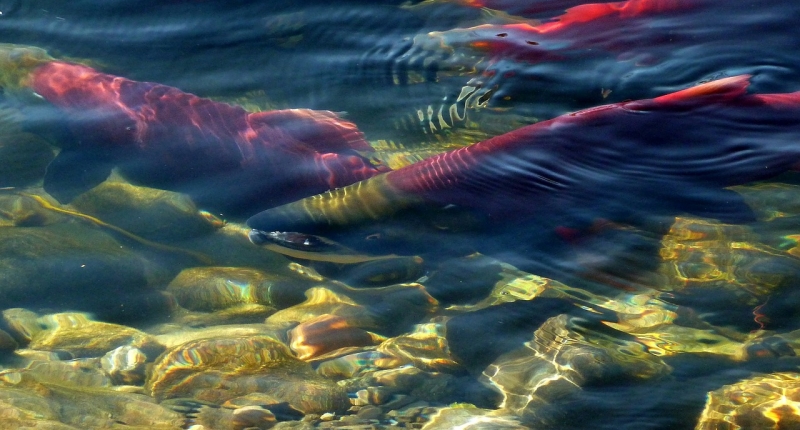Disentangling the Effects of Competition and a Warming Ocean on Sockeye Salmon across the Northeast Pacific

How does a warming and more crowded ocean affect salmon across their range? A group of scientists from Fisheries and Oceans Canada, the National Oceanic and Atmospheric Administration, Natural Resources Consultants, the University of Alaska and the Prince William Sound Science Center set out to answer this question and published their findings in the Canadian Journal of Fisheries and Aquatic Sciences on May 26th. They compiled a large sockeye salmon data set of 47 stocks across the Northeast Pacific along with information on ocean temperatures during their early marine life and the abundance of potential salmon competitors later in marine life to quantify their relationships with sockeye survival over the past 35 plus years.
What the team found was that a warm ocean and abundant salmon competitors combine to reduce sockeye survival for southern stocks including those from the Fraser River in British Columbia some of which have been assessed as at risk of extinction and are now contending with a landslide blocking upriver passage to their spawning grounds. In contrast in northern stocks, including those in Bristol Bay where record setting returns in recent years have supported large commercial fisheries, a warm ocean substantially increases survival and appears to offset the negative effects of competition at sea.
These findings reveal that the effects of a warming ocean and competition among salmon for food at sea vary over a large geographic area. They also help to explain, at least in part, why sockeye salmon stocks are faring so poorly in the southern portion of their range but generally doing well in the northern end of their range.
While the majority of salmon come from wild populations, industrial scale hatchery production increasingly contributes to the number of salmon at sea. For example, the abundance of hatchery pink salmon from 2005–2015 (82 million adults per year, or 17% of all pink salmon) exceeded the abundance of wild chum salmon and was equal to the abundance of wild sockeye over the same time period. In addition, there are strong geographic differences in hatchery production. For example, Alaskan hatchery production of pink salmon represented 18%–49% of total annual pink salmon produced in Alaska from 2005 to 2015. Based on the results of their analysis the authors estimate that hatchery produced pink salmon has reduced the survival of southern sockeye salmon by ~15%, on average. In contrast, for sockeye at the northern end of their range, the same level of hatchery production was estimated to have reduced the positive effects of a warming ocean by 50% (from a ~10% to a ~5% increase in survival, on average).
Though a growing body of evidence suggests that competition among salmon at sea can influence salmon growth, maturity, and survival, the potential for food resources to limit salmon production across the North Pacific continues to be vigorously debated. As a result some jurisdictions (e.g., Alaska and Russia) continue to allow increasing hatchery production of pink and chum salmon with minimal consideration of the potential for adverse effects on distant salmon populations, including those that are declining.
“Our finding that industrial hatchery production of salmon in some regions may negatively impact salmon from other regions highlights the importance of international cooperation among nations to consider and potentially constrain the number of hatchery salmon released into the ocean, something that has been called for for decades” said Dr. Brendan Connors, one of the lead authors of the study and a Research Biologist with Fisheries and Oceans Canada.
And the consequences of increasing abundances of wild and hatchery pink salmon across the North Pacific may be felt by more than just other salmon. “Our work contributes to a growing body of evidence that increasing abundances of salmon across the North Pacific, and in particular pink salmon, are linked to a trophic cascade resulting in fewer zooplankton, reduced growth, survival and delayed maturation of salmon and other marine fishes, reduced reproductive success of seabirds, and perhaps even reduced foraging efficiency of southern resident killer whales” says Dr. Greg Ruggerone Vice President of Natural Resources Consultants and co-author on the study.
This study is the result of research undertaken as part of a working group funded by the State of Alaska Salmon and People (SASAP) project, a partnership between the National Center for Ecological Analysis and Synthesis (NCEAS) and Anchorage-based Nautilus Impact Investing that is funded by the Gordon and Betty Moore Foundation.
